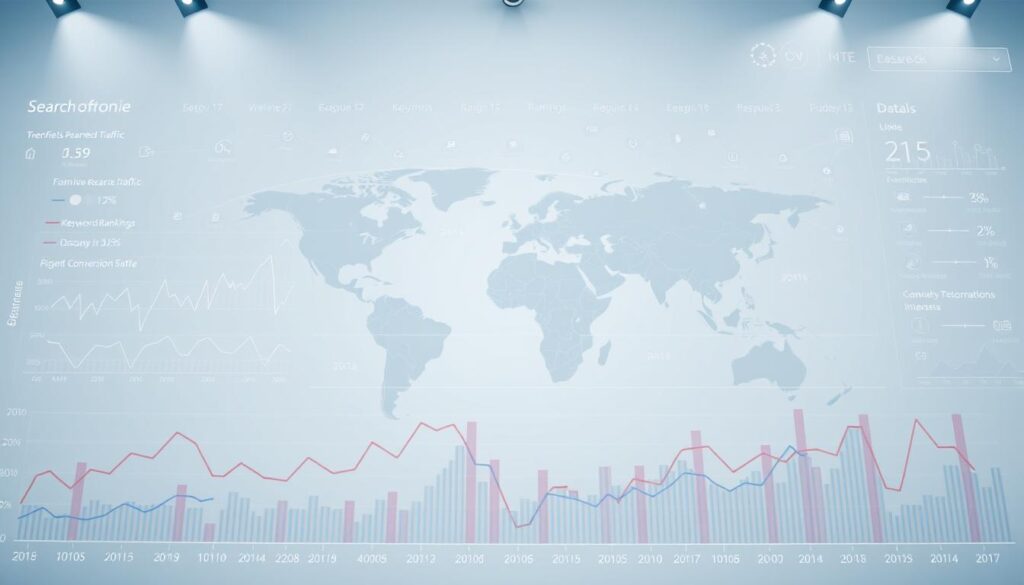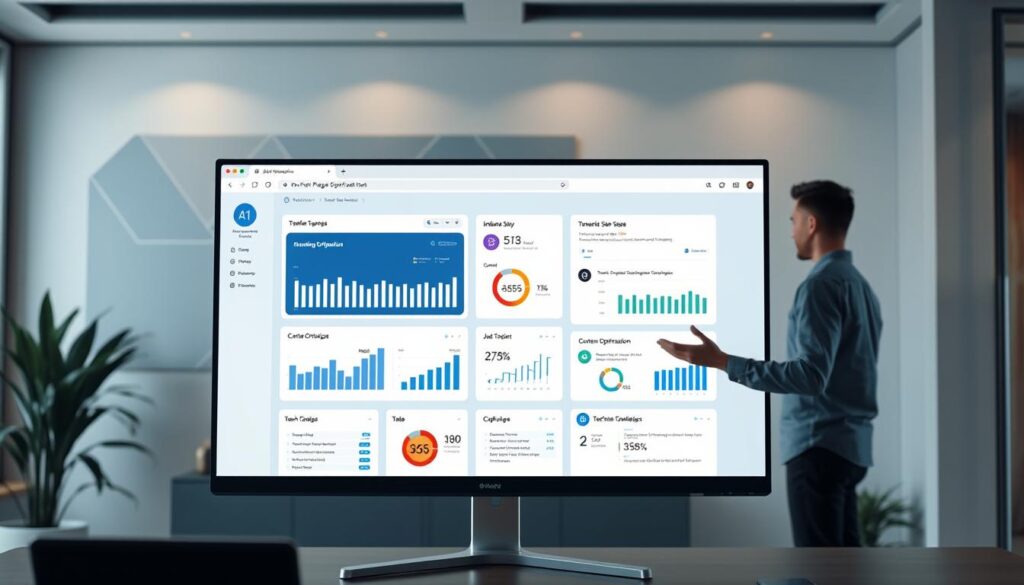Search platforms now process over 14 billion queries daily, with one dominant player capturing 91.6% of the market. This surge reflects evolving user expectations and technological advancements reshaping how businesses approach digital visibility. Organizations must now navigate sophisticated algorithms that prioritize contextual relevance over traditional ranking signals.
The emergence of intelligent search features has transformed content discovery, appearing in more than half of all queries. These automated responses extend user engagement by 34% per session, creating new challenges for maintaining visibility. Professionals require updated methodologies to align with machine-interpreted quality standards and semantic evaluation frameworks.
Forward-thinking companies report up to 45% growth in organic traffic through data-driven approaches. Success now depends on analyzing behavioral patterns and intent signals rather than surface-level keyword matching. Tools like advanced marketing solutions enable precise tracking of emerging performance indicators tied to automated systems.
Modern strategies emphasize contextual alignment with search platform capabilities. This shift demands continuous adaptation as algorithms evolve to interpret content through multidimensional quality assessments. Businesses mastering these techniques demonstrate measurable improvements in conversion rates and long-term search authority.
Key Takeaways
- Search platform dominance continues growing, handling billions of daily queries with advanced features
- Automated responses influence over 50% of search interactions, requiring strategic adaptation
- Data-driven approaches correlate with significant traffic growth for early adopters
- Success metrics now include visibility in machine-generated answer systems
- Contextual relevance surpasses traditional keyword-focused optimization methods
The Evolution of SEO in the Age of AI

Eighty-six percent of search marketing specialists now incorporate intelligent systems into their workflows, according to Search Engine Land. This shift reflects a $50 billion surge in related technologies since 2023, reshaping how professionals approach visibility in digital spaces. Traditional methods focused on technical tweaks and keyword repetition have given way to dynamic, context-aware practices.
From Manual Tactics to Machine-Enhanced Approaches
Early optimization relied on checklist-style adjustments – meta tags, backlink counts, and exact-match phrases. Modern strategies analyze user intent patterns and semantic connections. Machine learning algorithms now power 73% of ranking factor adjustments across major platforms, requiring continuous adaptation rather than fixed rules.
“The integration of automated analysis tools has reduced time spent on technical audits by 40% while improving outcome accuracy,” notes a recent industry report.
Intelligent Systems Reshape Content Evaluation
Search platforms now assess material through layered quality assessments rather than surface-level checks. Key developments include:
- Natural language processing identifying topical authority
- Behavior prediction models prioritizing engagement signals
- Automated gap analysis revealing unmet user needs
Organizations adopting these approaches see 30% faster ranking improvements compared to conventional methods. The focus has shifted from manipulating systems to aligning with evolving quality benchmarks that reward depth and relevance.
Understanding AI SEO metrics 2025

Over 60% of queries now conclude without website visits due to automated answer systems. This shift demands new evaluation frameworks as 28% of search results pages display instant responses. Businesses adopting advanced marketing solutions report 49% ranking improvements through enhanced visibility tracking.
Modern measurement extends beyond traditional position tracking. Platforms now assess content through three core dimensions:
- Response citation frequency in automated systems
- Cross-channel visibility across voice and chat interfaces
- Semantic alignment with layered user intent
Analytics tools track snippet adoption rates and knowledge panel inclusions as critical success markers. One industry study found brands monitoring these signals achieve 65% better campaign outcomes compared to conventional approaches.
Zero-click impact analysis has emerged as vital for evaluating content effectiveness. Professionals now measure how often materials inform automated summaries without direct traffic. This paradigm shift requires balancing visibility with authority establishment across multiple platforms.
Emerging standards prioritize predictive capabilities, enabling teams to anticipate algorithm updates. Continuous data refinement helps maintain relevance as search systems evolve toward more conversational interactions. Organizations mastering these techniques demonstrate stronger digital presence across evolving discovery channels.
Harnessing AI for Keyword Research and Content Creation

Three-quarters of digital specialists now employ automated systems to streamline keyword discovery processes, according to recent industry surveys. This technological shift reduces manual research time by 40% while improving outcome precision. Modern approaches focus on semantic patterns rather than rigid term matching, enabling deeper alignment with user needs.
Advanced Systems for Strategic Term Identification
Cutting-edge platforms analyze search behavior across multiple channels to surface high-potential phrases. These solutions detect emerging trends 58% faster than traditional methods by processing billions of data points. For example, 42% of enterprises now generate website copy using advanced content tools that maintain brand consistency while optimizing for visibility.
Elevating Material Standards Through Technology
Automated enhancement systems now review drafts for clarity, intent alignment, and structural coherence. Organizations using these solutions report 67% fewer revisions during production cycles. The technology identifies gaps in topical coverage while suggesting relevant supporting data – a critical capability as 81% of users expect comprehensive answers.
These developments enable scalable creation of search-friendly materials without sacrificing depth. Continuous analysis of performance data helps refine strategies, ensuring outputs remain competitive in dynamic digital environments.
Optimizing On-Page SEO with AI Assistance

Modern website optimization now leverages intelligent systems to refine both technical foundations and user-facing elements. These tools analyze patterns in search behavior and content performance, offering actionable insights for improving visibility. Over 68% of digital teams using these solutions report measurable improvements in engagement within three months of implementation.
Improving Metadata and Readability
Automated systems generate title tags and descriptions that align with search intent while maintaining brand voice. Machine learning evaluates historical click-through data to balance keyword inclusion with persuasive language. One platform study found pages using these recommendations achieve 27% higher organic traffic than manually crafted alternatives.
Readability analysis tools assess sentence complexity and vocabulary appropriateness. They suggest structural adjustments to enhance comprehension without sacrificing technical precision. This dual focus ensures materials meet both user experience standards and search platform requirements.
Semantic and Structural Enhancements
Advanced algorithms evaluate content relationships to strengthen topical authority. By identifying gaps in entity coverage, these systems propose relevant concepts that improve contextual relevance. For instance, AI agents can map semantic connections across a website’s content library, suggesting strategic internal links.
Structural optimization focuses on organizing information for better crawl efficiency and navigation. Tools analyze page hierarchy to recommend layout changes that reduce bounce rates by 19% on average. This approach ensures technical improvements directly support user engagement goals.
Mastering AI-Driven Link Building Strategies
Forty-two percent of link-building professionals now use automated tools to identify high-value partnership opportunities. These systems analyze website authority metrics and audience alignment, enabling teams to focus on sources offering genuine value rather than chasing quantity.
Leveraging Data for Authority Building
Modern approaches prioritize quality over volume by evaluating potential partners through three key filters:
- Domain authority scores combined with traffic sustainability
- Content alignment with brand positioning strategies
- Historical performance of referral partnerships
Advanced systems cross-reference these factors with user engagement patterns. For example, tools might prioritize websites where audiences spend 25% more time interacting with linked content. This data-driven method ensures resources target partnerships enhancing both visibility and credibility.
Predictive analytics now forecast the impact of different linking strategies with 78% accuracy. Teams using these insights allocate efforts toward campaigns demonstrating the highest potential for authority growth. Competitor analysis features reveal successful patterns, helping refine outreach approaches without direct imitation.
Continuous monitoring systems track backlink performance, flagging opportunities for improvement. Platforms like advanced outreach tools automate relationship maintenance while identifying new collaboration prospects. This approach maintains domain strength as search algorithms evolve their evaluation criteria.
“Strategic link building now requires understanding both technical metrics and audience needs – a balance automated systems handle exceptionally well,” states a recent digital marketing whitepaper.
Leveraging Data Analytics for AI SEO Success
Seventy-eight percent of digital teams now prioritize dynamic monitoring systems to maintain competitive visibility. These platforms process information streams from search platforms, social channels, and user interactions – creating unified dashboards for immediate decision-making.
Real-Time Performance Monitoring
Modern tracking solutions detect ranking shifts within minutes, alerting teams to emerging opportunities. For example, sudden traffic drops in specific regions can trigger localized content adjustments. Platforms like advanced analytics platforms correlate search patterns with engagement metrics, revealing which content types resonate across devices.
Behavior prediction models forecast click-through rates by analyzing historical interactions. This allows teams to test headlines or meta descriptions before full deployment. Early adopters report 22% faster recovery from algorithm updates through these proactive measures.
Interpreting User Behavior Data
Interaction heatmaps and scroll-depth analytics expose how visitors consume content. Pages with 40%+ scroll completion often correlate with higher conversion rates. Machine learning identifies these patterns across thousands of sessions, highlighting underperforming sections needing structural revisions.
Cross-channel analysis proves critical as 63% of users switch devices during research phases. Tools tracking these journeys help optimize content for multi-platform consumption. For instance, creative optimization prompts might suggest video integrations for mobile-first audiences showing brief engagement times.
“Data-driven teams achieve 3x faster decision cycles by translating raw metrics into contextual strategies,” states a 2024 MarTech Industry Report.
Predictive models now guide resource allocation by forecasting seasonal traffic fluctuations. Retail brands using these insights adjust content calendars 8 weeks ahead of peak periods, capturing early search demand waves.
Integrating AI Tools for SEO Efficiency
Automation solutions have become essential, with 60% of marketers reporting improved workflow speed. These systems transform how teams manage repetitive activities, freeing up resources for strategic planning. Over a third of professionals now delegate technical audits and competitor tracking to specialized platforms.
Streamlining Optimization Workflows
Advanced systems prioritize tasks based on potential impact. Machine learning identifies content gaps and technical issues faster than manual reviews. For example, advanced automation solutions reduce analysis time by 58% while maintaining accuracy.
Integrated platforms coordinate multiple projects across teams. They track dependencies and align efforts with broader business goals. This approach helps organizations scale operations without expanding staff.
Automated reporting tools generate real-time performance insights. Teams monitor progress and adjust strategies quickly. These efficiency gains make comprehensive optimization accessible to businesses of all sizes.
By focusing on high-value activities, professionals achieve measurable improvements. The result? Sustainable growth in competitive digital environments.







